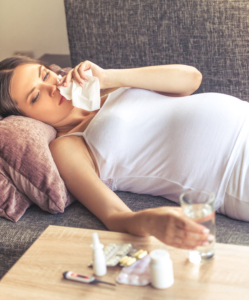2019-2020 Influenza Vaccine Season – FAQ
By: Taylor Lukas, PA-C

Every year, the influenza virus causes unwanted, often severe, upper respiratory infections across the US during the months of October-May.
Influenza viruses A and B are the culprits for these infections, and if contracted, can cause
- high fevers
- severe coughing
- fatigue
- body aches
- other upper respiratory symptoms
Consequences of this infection can range from physical discomfort and missed days from work for a young, healthy adult, to potentially severe and life-threatening complications for small children, chronically ill adults, pregnant women, and the elderly population. In the 2018-2019 season, the CDC estimated there were over 530,000 hospitalizations and over 37,000 deaths associated with influenza! Fortunately, we have an annual vaccine that targets the anticipated strains of the virus for that season and can help reduce our risk of infection! Below are a few commonly asked questions and concerns regarding the flu vaccine to help you make an informed decision.
Who should get the influenza vaccine, and when?
The flu vaccine is recommended by the CDC for all patients over 6 months of age (that do not have a contraindication to the vaccine). The vaccine is HIGHLY recommended for any adult with chronic medical conditions such as
- asthma/COPD
- diabetes
- chronic kidney or liver disease
- HIV
- cancer
- morbid obesity
- elderly patients >65 years of age
- pregnant women are strongly encouraged to get vaccinated due to risks associated with contracting the virus during pregnancy.
The ideal time to be vaccinated is before November, however it is beneficial to be vaccinated at any time during the flu season!
I am fairly healthy and don’t get sick often! Why do I need to get the influenza vaccine?
Even if the virus may not be more than an inconvenience to you, it could mean a life-threatening situation if you are to accidentally pass it along to an elderly or sick individual! You are helping protect others that may be unable to get the vaccine, as well as yourself, when you get vaccinated! Additionally, if you do catch the flu despite getting the vaccine, immunization is shown to reduce the SEVERITY and LENGTH of the illness, which allows you to get back to feeling better faster!
I always feel under the weather after I get the flu vaccine. Can I get sick from the flu vaccine?
The influenza vaccine typically administered contains an inactivated (dead) virus, so it is impossible to contract influenza from the vaccine itself. The most common side effect of a flu vaccine is arm soreness for 2-3 days after administration. Some patients report experiencing a mild headache, fatigue, or body aches after receiving the vaccine, however studies do not support a direct relationship between the vaccine itself and these symptoms. These mild potential side effects pale in comparison to the influenza symptoms that you will have protection from!
The start of the 2019-2020 influenza season is quickly approaching! Please come in and see us at any of our NOAH locations to receive a flu vaccine! Your medical provider can answer any additional questions or concerns at your office visit, and choose the flu vaccine that is appropriate for you! Here’s to a happy and healthy winter season!

